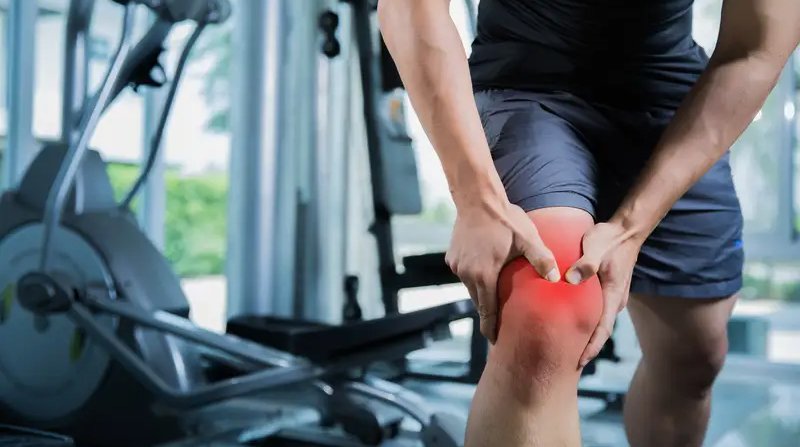One wrong move is all it takes to go from fit to frustrated.

You’re grinding through your sets, pushing your limits, and finally seeing real progress. The mirror shows results. Your lifts are climbing. You feel invincible — until that sharp stab in your shoulder mid-rep makes you drop the weight and realize something’s very wrong.
Now you’re icing your joints instead of building muscle, watching weeks or months of gains disappear while you scroll through “how to fix my shoulder” at midnight.
Here’s the wake-up call: You train hard — don’t let injury set you back months or years. But if you’re working out without proper form correction, that’s exactly where you’re headed. You’re not building an athlete’s body. You’re building a perfectly engineered injury waiting to happen.
The Injury Epidemic Hiding in Plain Sight
Every gym has them. The guy whose knees cave inward during squats. The woman whose shoulders hunch up during overhead press. The runner whose hips drop with every stride. These aren’t minor technique flaws — they’re ticking time bombs.
Studies show that up to 30% of regular gym-goers experience workout injuries every year that disrupt their training. But here’s the kicker: most of these aren’t from accidents or ego-lifting gone wrong. They develop slowly from repetitive poor form that compounds over hundreds of reps until something finally breaks.
That rotator cuff tear didn’t happen overnight. It’s been brewing for months from improper shoulder mechanics. That herniated disc? Years of loading a rounded spine finally caught up. That knee pain? Your weak hips have been forcing your knees to compensate since your first squat.
The Three Injury Triggers Hiding in Your Workouts
1. Bad Form: The Slow-Motion Disaster
You’ve watched the tutorials. You think your form looks good. But here’s the problem: you can’t see your own blind spots.
That tiny hip shift during squats? You don’t notice it, but your lower back does. The slight shoulder roll during bench press? Imperceptible to you, devastating to your rotator cuff over time. The wrist angle during push-ups? It feels fine until the tendinitis arrives.
Poor form isn’t always obvious. It’s often subtle compensations your body makes to work around weaknesses — exploiting your strengths while quietly destroying your vulnerable joints.
2. Weak Stabilizers: The Missing Foundation
Everyone wants bigger arms, stronger legs, and six-pack abs. Nobody gets excited about training their rotator cuff muscles, deep core stabilizers, or hip abductors. But these unglamorous stabilizer muscles are what keep your joints safe when you’re lifting heavy.
When stabilizers are weak, the wrong muscles take over. Your lower back compensates for a weak core. Your upper traps overwork for unstable shoulder blades. Your IT band tries to stabilize what your glutes should be controlling.
This creates a dangerous pattern: your strong muscles get stronger, your weak muscles get weaker, and your joints pay the price for the imbalance.
3. Muscle Imbalances: The Asymmetry Time Bomb
Your right side is stronger than your left. Your chest overpowers your back. Your quads dominate while your hamstrings lag behind. These imbalances might let you lift more weight temporarily, but they’re creating uneven forces that grind down your joints.
Every rep you perform with a muscle imbalance is accelerating the breakdown. Your strongest muscles keep getting stronger, your weak ones keep getting weaker, and eventually, something snaps.
The Workout Injuries You’re Currently Training For
Let’s get specific about what’s developing right now if you’re ignoring form and balance:
Shoulder Impingement: Every overhead press with poor scapular control pinches the soft tissues in your shoulder. It starts as a dull ache after heavy days. Then it’s there during workouts. Eventually, you can’t lift your arm to put on a shirt.
Lower Back Strain: When your core can’t stabilize your spine during deadlifts or squats, your back muscles work overtime to protect you. That post-workout tightness you stretch away? That’s your back screaming that it’s doing a job it wasn’t designed for.
Knee Pain: Hip weakness forces your knee inward during loaded movements. Your IT band tightens, your kneecap tracks poorly, and eventually, you’re dealing with chronic pain that derails every leg day.
Tennis Elbow: Grip-intensive exercises with poor wrist positioning inflame your elbow tendons. It starts as a weird ache after bicep curls. It ends with you unable to hold a coffee cup without pain.
How Sports Injury Prevention Changes Everything
This is where professional physiotherapy becomes your secret weapon. A movement assessment isn’t about treating existing injuries — it’s about identifying vulnerabilities before they sideline you.
Here’s what a comprehensive sports injury prevention evaluation includes:
Movement Pattern Analysis: A trained eye watches you perform your typical exercises and spots the compensations you can’t see. The hip hike during lunges. The shoulder elevation during rows. The spinal rotation during planks. These invisible flaws are destroying your joints.
Muscle Imbalance Testing: Systematic evaluation of strength ratios between opposing muscle groups. Are your hamstrings strong enough relative to your quads? Can your external shoulder rotators balance your internal rotators? Can your core actually stabilize under the loads you’re attempting?
Flexibility and Mobility Screening: Your joints need adequate range of motion for proper form. Limited ankle mobility guarantees bad squat form. Tight hip flexors ensure lower back compensation. Restricted thoracic mobility forces your shoulders into dangerous positions.
Functional Movement Screening: Tests that expose weaknesses only visible during specific activities. Single-leg balance reveals hip instability. Overhead reaching tests shoulder mechanics. Rotational movements expose core control deficits.
The Physiotherapy Advantage for Serious Athletes
Professional guidance doesn’t just prevent workout injuries — it makes you a better, stronger, more efficient athlete:
Corrective Exercise Prescription: Targeted exercises that address your specific weaknesses. Not random mobility drills from social media. Systematically chosen interventions based on your unique biomechanical profile.
Real-Time Form Coaching: Immediate feedback that a mirror can’t provide. A physiotherapist doesn’t just say “keep your back straight” — they identify why your back rounds (weak hamstrings? tight hip flexors? poor ankle mobility?) and give you the exact tools to fix it.
Progressive Loading Strategies: Learn when to push harder and when form breakdown signals you’ve hit your current limit. This prevents the common mistake of adding weight before your body is ready.
Smart Return-to-Training Protocols: If you’re already dealing with an injury, systematic progression under professional guidance ensures you come back stronger instead of re-injuring yourself.
The Real Cost of Ignoring Prevention
A few physiotherapy sessions for sports injury prevention assessment might cost you a couple hundred dollars and a few hours of your time.
Compare that to:
- Months of missed training and lost progress
- Hundreds or thousands spent treating established injuries
- Potential surgery and extensive rehabilitation
- Permanent strength loss or range of motion limitations
- The mental toll of watching your fitness goals disappear
Every workout you do with uncorrected form is a withdrawal from your body’s injury bank. Eventually, you’ll overdraft.
Your Body Is Sending Warnings
That slight shoulder discomfort you’re pushing through? Warning sign. The lower back tightness every morning? Red flag. The knee that sometimes feels “off” during squats? Countdown timer.
Your body is resilient, but not indestructible. Every rep with poor form, every workout without adequate stability, every session reinforcing muscle imbalances is quietly eroding your injury threshold.
The question isn’t if something will break down. It’s when.
The Smart Athlete’s Approach
Real strength isn’t just about how much weight you can move — it’s about how efficiently and safely you can move it. The strongest athletes aren’t the ones who ignore warning signs and push through pain. They’re the ones who:

- Invest in movement quality before chasing numbers
- Address weaknesses before they become injuries
- Understand that sports injury prevention is performance enhancement
- Train smart enough to still be training at full capacity years from now
Take Action Before You’re Sidelined
If you’re serious about long-term fitness, book a movement assessment with a physiotherapist who specializes in sports injury prevention. They’ll:
- Evaluate your exercise form with a trained eye
- Test your stability and identify hidden weaknesses
- Measure muscle imbalances creating injury risk
- Create a targeted plan to bulletproof your body
The best time to prevent a workout injury was before you started training. The second-best time is right now.
Don’t wait until you’re watching from the sidelines, wondering what went wrong. Because the athletes who train hardest aren’t always the ones who progress fastest — it’s the ones who train smartest who are still crushing their goals years later.
Your future self will either thank you for taking prevention seriously, or regret that you waited until it was too late.





